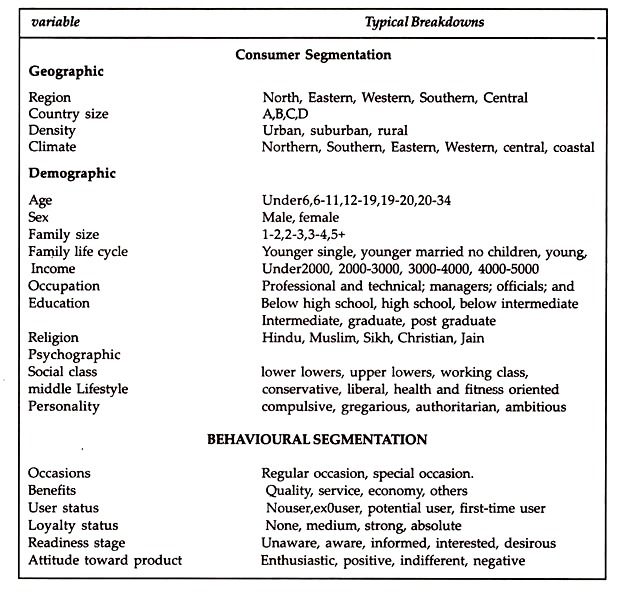This article throws light upon the four main components of Enterprise Marketing Automation (EMA) to gain some insight as to how CRM can benefit an enterprise. The components are: 1. Market Segmentation 2. Campaign Management 3. Customer Service and Support 4. Contact and Call Centre Operations.
EMA: Component # 1. Market Segmentation:
Market segmentation is the process of identifying smaller markets that exist within a larger market. These groups are called market segments. Market segmentation helps marketer develop marketing mixes for individual segments. Market segmentation helps marketers develop marketing mixes that are more specially tailored to the characteristics and wants of people of the segments that are identified and selected as target markets.
“Market segmentation breaks the larger heterogeneous market into smaller homogenous markets. The elements of each smaller segment are more similar in terms of wants, needs and behavior than the total market is. a separate marketing programmes is developed to best match each segment, individual needs and wants.” Schewe and Smith
“the process of taking the total heterogeneous market for a product and dividing it into several submarket or segment, each of which tends to be homogenous in all significant aspects.” W.J. Stanton.
ADVERTISEMENTS:
Segmentation isolates consumers with similar life styles, needs and the likes and increases our knowledge of their specific requirements. The more marketers establish this common ground with consumers, the more effective they will be in assessing these requirements in their communication programmes and informing and/or persuading potential consumers that the product or service offering will meet their needs
Segmenters aim at one or more homogeneous segments and try to develop a different marketing mix for each segment, segmenters may make more basic changes in marketing mixes, perhaps in the product itself-because they are aiming at smaller target markets.
Benefits /purpose of market segmentation:
Market segmentation is a customer oriented philosophy we first identifies the needs of customers with in a segment and then satisfy those needs.
ADVERTISEMENTS:
Benefits offered by segmentation can be summarized as follows:
1. By developing strong position in specialized market segments, medium sized firms can achieve a rapid growth rate.
2. By tailoring the marketing programmmes to individual market segments, marketer can do a better marketing job and make more efficient use of marketing resources.
3. People awareness is increasing in relation to their preferences. In these circumstances it is necessary that marketer must segment and then try to fulfill the needs of the segment.
ADVERTISEMENTS:
4. It helps in determining the kinds of promotional devices that are effective and also helps to evaluate their results.
5. Appropriate decision making, relating to introducing of new products, promotion, distribution, pricing could be easily taken.
Market segmentation procedure:
It is not possible to develop the marketing strategies for every customer. Rather marketer attempts to identify broad classes of buyers who have the same needs and wants and will respond similar to a marketing action.
ADVERTISEMENTS:
Market segmentation is dividing up to market into distinct groups that:
{a} have common market
{b} will respond similarly to a marketing action.
The segmentation process involves following distinct steps:-
ADVERTISEMENTS:
Step-1: survey step:
The researcher conduct interviews with the consumers to take the response from them relating to their motivation, attitudes and behavior. For conducting the survey, the researcher prepares a questionnaire and applies it to the some of the potential customers.
Step -2: Analysis stage:
After collecting the responses from the respondents the next stage is to turn them into meaningful from thorough analysis using factor analysis. After that the researcher applies cluster analysis to make strata of homogenous responses.
ADVERTISEMENTS:
Step-3.Profiling stage:
Each’ homogenous cluster is now profiled in terms of its distinguishing attitudes, psychographic, geographic, and demographic and consumption habits. Each segment can be given a differentiating name.
Bases for consumer market segmentation:
Market can be segmented into various segments by using different bases. Bases of market segmentation can be broadly divided into two broad categories. Consumer characteristics {consumer segmentation} and consumer responses {product related segmentation}.the following chart and gives the detail of available base of segmentation.
ADVERTISEMENTS:
1. Consumer characteristic tics
2. Demographic status
3. Geographic status
4. Psychographic status
5. Consumer responses
6. Occasion
ADVERTISEMENTS:
7. Benefits
8. User status
9. Loyalty status
10. Attitudes status
EMA: Component # 2. Campaign Management:
Campaign management encompasses the multitude of campaigns that are plant an executed through different channels so that a continuous marketing communication flow is created . Sometimes these campaigns are devised in the morning and executed that every afternoon.
ADVERTISEMENTS:
By continuously measuring the effect of every contact “customer touch point” and making adjustments, the dialogue may be continually refined. This puts the organization in a better position to market its goods and services and develop relationship with the right customers. The goal of campaign management is to interact with prospects and customers at the right movement, with the rights offerings and the right message communicated through the right channels.
EMA: Component # 3. Customer Service and Support:
Customer service is the service or care that a consumer receives before, during and after a purchase. It’s one of the factors that come in to play when a consumer is determining buying value, the other is the quality of the product or service that is being offered. Consumers often must encounter an experience to not only be a satisfied customer, but a loyal customer.
Customer service is a part of that experience. Top notch service will create loyalty and a returning customer, which is what we all must strive for. Excellent customer service is vital to businesses today. It’s a component that is often missing, unfortunately. How do you provide great customer service? Always make your customer a priority.
Greet them in a friendly manner, whether that be via telephone, email or in person. Let them know you are there to help and that you will take care of them, not only before the sale but after as well. After all, in a thriving business customers are not optional it’s a requirement for businesses to survive.
EMA: Component # 4. Contact and Call Centre Operations:
A contact centre, also known as customer interaction centre is a central point of any organization from which all customer contacts are managed. Through contact centres, valuable information about company are routed to appropriate people, contacts to be tracked and data to be gathered. It is generally a part of company’s customer relationship management (CRM). Today, customers contact companies by calling, emailing, chatting online, visiting websites, faxing, and even instant messaging.
Call centre worker at a very small workstation/booth, using Call Web Internet-based survey software, “most companies use statistics from their call center products to track their CSR(customer service representative) performance, evaluating their performance and compensating them according to the volume of calls they support.

